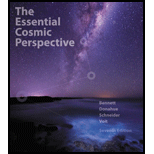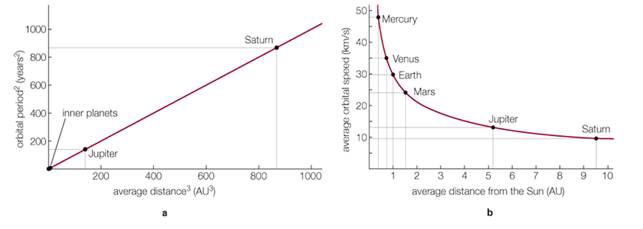
The Essential Cosmic Perspective (7th Edition) - Standalone book
7th Edition
ISBN: 9780321928085
Author: Jeffrey O Bennett, Megan O. Donahue, Nicholas Schneider, Mark Voit
Publisher: PEARSON
expand_more
expand_more
format_list_bulleted
Textbook Question
Chapter 3, Problem 4VSC
Use the information in the graphs to answer the following questions.
Check your understanding of some of the many types of visual information used in astronomy. For additional practice, try the Chapter 3  Visual Quiz at Mastering Astronomy.
Visual Quiz at Mastering Astronomy.

4. Kepler’s third law is often stated as p2= a3. The value a3for a planet is shown on .
a. the horizontal axis of Figure a
b. the vertical axis of Figure a
c. the horizontal axis of Figure b
d. the vertical axis of Figure b
Expert Solution & Answer
Want to see the full answer?
Check out a sample textbook solution
Students have asked these similar questions
Find the ratio of the diameter of silver to iron wire, if they have the same resistance per unit length (as they might in household wiring).
d
Ag
= 2.51
dFe
×
Show that the units 1 v2/Q = 1 W, as implied by the equation P = V²/R.
Starting with the equation P = V²/R, we can get an expression for a watt in terms of voltage and resistance. The units for voltage, V, are equivalent to [?
v2
v2
A, are equivalent to J/C ✓ X . Therefore, 1
= 1
= 1 A V1 J/s
Ω
V-A X
= 1 W.
. The units for resistance, Q, are equivalent to ?
The units for current,
Please solve and answer the question correctly please. Thank you!!
Chapter 3 Solutions
The Essential Cosmic Perspective (7th Edition) - Standalone book
Ch. 3 - Prob. 1VSCCh. 3 - Use the information in the graphs to answer the...Ch. 3 - Use the information in the graphs to answer the...Ch. 3 - Use the information in the graphs to answer the...Ch. 3 - Use the information in the graphs to answer the...Ch. 3 - Use the information in the graphs to answer the...Ch. 3 - Use the information in the graphs to answer the...Ch. 3 - In what way is scientific thinking natural to all...Ch. 3 - Prob. 2EAPCh. 3 - What is a lunar calendar? How can it be kept...
Ch. 3 - What do we mean by a model in science? Briefly...Ch. 3 - What do we mean by the Ptolemaic model? How did...Ch. 3 - What was the Copernican revolution, and how did it...Ch. 3 - What is an ellipse? Define its foci, semimajor...Ch. 3 - State and explain the meaning of each of Kepler’s...Ch. 3 - Describe the three hallmarks of science and...Ch. 3 - What is the difference between a hypothesis and a...Ch. 3 - Each of the following statements makes some type...Ch. 3 - Each of the following statements makes some type...Ch. 3 - Each of the following statements makes some type...Ch. 3 - Each of the following statements makes some type...Ch. 3 - Each of the following statements makes some type...Ch. 3 - Each of the following statements makes some type...Ch. 3 - Each of the following statements makes some type...Ch. 3 - Each of the following statements makes some type...Ch. 3 - Each of the following statements makes some type...Ch. 3 - Prob. 20EAPCh. 3 - Choose the best answer to each of the following....Ch. 3 - Choose the best answer to each of the following....Ch. 3 - Choose the best answer to each of the following....Ch. 3 - Choose the best answer to each of the following....Ch. 3 - Choose the best answer to each of the following....Ch. 3 - Choose the best answer to each of the following....Ch. 3 - Choose the best answer to each of the following....Ch. 3 - Choose the best answer to each of the following....Ch. 3 - Choose the best answer to each of the following....Ch. 3 - Choose the best answer to each of the following....Ch. 3 - Prob. 31EAPCh. 3 - Earth’s Shape. It took thousands of years for...Ch. 3 - Prob. 33EAPCh. 3 - Prob. 34EAPCh. 3 - Prob. 35EAPCh. 3 - Prob. 36EAPCh. 3 - Prob. 37EAPCh. 3 - Prob. 38EAPCh. 3 - Halley Orbit. Halley’s comet orbits the Sun every...Ch. 3 - Prob. 40EAPCh. 3 - 41. The Importance of Ancient Astronomy. Why was...Ch. 3 - Prob. 42EAPCh. 3 - Prob. 43EAPCh. 3 - The Galileo Affair. In recent years. the Roman...Ch. 3 - Prob. 45EAP
Knowledge Booster
Learn more about
Need a deep-dive on the concept behind this application? Look no further. Learn more about this topic, physics and related others by exploring similar questions and additional content below.Similar questions
- What is the equivalent resistance between points A and B of the network shown in the figure? A • 12 B 4.0 6.0 Ω 8.0 Ωarrow_forwardAccording to the provided information answer the question accorrding to grade 11 physics Jerry has decided to give up his part-time job for a new career, cat-burglar! Jerry loves the idea of dressing up like a cat all day and of course the chance of meeting Cat Woman! On Jerry's first "job" he figures out his escape plan. He travels 3.0 km south for 15 minutes and then 8.0 km west for 1.5 hours before reaching his house. Draw a sketch diagram of the path he took with all the appropriate labels.arrow_forwardPlease solve and answer all parts of the question correctly please. Thank you!!arrow_forward
arrow_back_ios
SEE MORE QUESTIONS
arrow_forward_ios
Recommended textbooks for you
 Foundations of Astronomy (MindTap Course List)PhysicsISBN:9781337399920Author:Michael A. Seeds, Dana BackmanPublisher:Cengage Learning
Foundations of Astronomy (MindTap Course List)PhysicsISBN:9781337399920Author:Michael A. Seeds, Dana BackmanPublisher:Cengage Learning Stars and Galaxies (MindTap Course List)PhysicsISBN:9781337399944Author:Michael A. SeedsPublisher:Cengage Learning
Stars and Galaxies (MindTap Course List)PhysicsISBN:9781337399944Author:Michael A. SeedsPublisher:Cengage Learning
 AstronomyPhysicsISBN:9781938168284Author:Andrew Fraknoi; David Morrison; Sidney C. WolffPublisher:OpenStax
AstronomyPhysicsISBN:9781938168284Author:Andrew Fraknoi; David Morrison; Sidney C. WolffPublisher:OpenStax Glencoe Physics: Principles and Problems, Student...PhysicsISBN:9780078807213Author:Paul W. ZitzewitzPublisher:Glencoe/McGraw-Hill
Glencoe Physics: Principles and Problems, Student...PhysicsISBN:9780078807213Author:Paul W. ZitzewitzPublisher:Glencoe/McGraw-Hill Horizons: Exploring the Universe (MindTap Course ...PhysicsISBN:9781305960961Author:Michael A. Seeds, Dana BackmanPublisher:Cengage Learning
Horizons: Exploring the Universe (MindTap Course ...PhysicsISBN:9781305960961Author:Michael A. Seeds, Dana BackmanPublisher:Cengage Learning

Foundations of Astronomy (MindTap Course List)
Physics
ISBN:9781337399920
Author:Michael A. Seeds, Dana Backman
Publisher:Cengage Learning

Stars and Galaxies (MindTap Course List)
Physics
ISBN:9781337399944
Author:Michael A. Seeds
Publisher:Cengage Learning


Astronomy
Physics
ISBN:9781938168284
Author:Andrew Fraknoi; David Morrison; Sidney C. Wolff
Publisher:OpenStax

Glencoe Physics: Principles and Problems, Student...
Physics
ISBN:9780078807213
Author:Paul W. Zitzewitz
Publisher:Glencoe/McGraw-Hill

Horizons: Exploring the Universe (MindTap Course ...
Physics
ISBN:9781305960961
Author:Michael A. Seeds, Dana Backman
Publisher:Cengage Learning
Time Dilation - Einstein's Theory Of Relativity Explained!; Author: Science ABC;https://www.youtube.com/watch?v=yuD34tEpRFw;License: Standard YouTube License, CC-BY